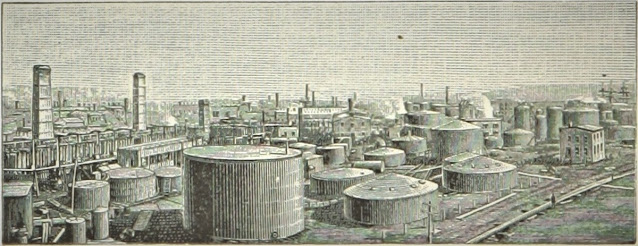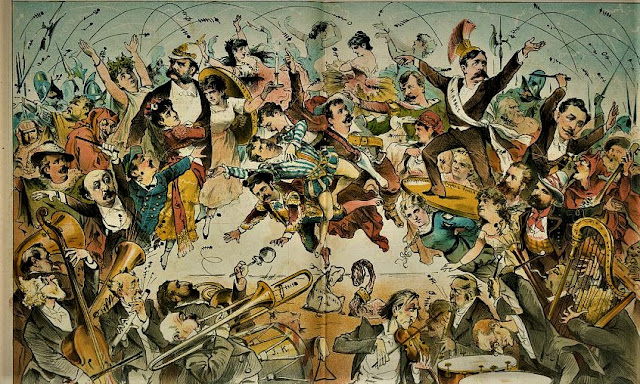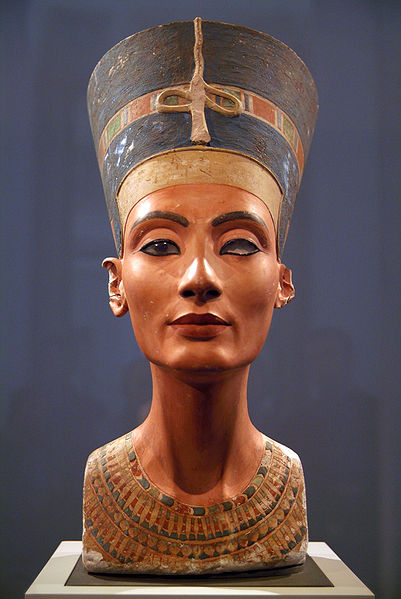I still wonder why they call it “news”? It is never “new”. As proof I give you the obtuse triangle of “Big” Jim Fisk, Helen Josie Mansfield and Edward Stokes (above); a triangle which would have bemused Sigmund Freud.
Jim Fisk (above) was born in Vermont on April Fools’ Day in 1835. His father was a traveling “bummer”, selling pots and pans and trifles. When he was 15, "Big" Jim ran away to join " Van Amberg's Mammoth Circus and Menagerie”, and returned three years later with a splash of color and bombast. By the age of 36 Fisk had marketed his talents for lying and cheating into a fortune of $70 million - the modern equivalent of one billion, one hundred twenty-nine million, one hundred ninety-eight thousand dollars.
In the midst of the Civil War, together with the most hated man in New York - his partner Jay Gould (above left) - Big” Jim (above, right) took over and then plundered the Erie Railroad.
But it was “Big” Jim who decided to move the Erie’s corporate offices into the upper three floors of the Grand Opera House (above), which he also owned. For while his partner Jay Gould (above) had no interests outside of making money, Jim Fisk was a man of many prodigious appetites, most involving divas of one kind or another. Jim had been married to his dearest Lucy when he was just 19, but she resided in far off Boston with her own lady love, Fanny Harrod.
And while Jim kept both ladies in luxury, and even visited them occasionally, he spent most of his free time with “actresses” in New York, and was a regular visitor at the business house of “the notorious Annie Wood”. And it was in the dim red light of Annie's parlor that Jim was introduced to his personal Helen of Troy, Helen Josephine Mansfield.
Josie, as she preferred to be known, was a beauty in an age when a sexy woman had some "meat on her bones". One admirer noted her “…full, dashing figure". He also noted "Her eyes are large, deep and bright…Her voice is very soft and sweet”.
It was Josie’s mother who first recognized the girl’s talent as “an incorrigible flirt”, and used her as bait in a badger game played in Stockton, California. A pettifogging local attorney named D.W. Perley , while in a state of undress, was caught "courting" the young Josie. To cover the scandal Perley wrote at least one check at gunpoint. There was some quarrel over the proceeds of this venture, and shortly thereafter Josie secretly married Frank Lawlor, an actor. The newlyweds then abandoned her mother, in search of greener fields.
She followed Frank cross-country on the music hall circuit, arriving in New York City in 1864. Here, two years later, Frank came to the shocking discovery that Josie “was going astray” on him. Although why that should have shocked him, seems an open question. In any case, they divorced, and Josie sought a career more suited to her talents, in the bordello of Annie Wood. There she enticed Annie to introduce her to the genial and jovial and generous Mr. Fisk. He was enchanted. She was enriched.
Over night Josie went from being behind in her rent to the “Cleopatra of West Twenty-third Street”, the owner of record of a four story brownstone (after some $65,000 worth of improvements) - conveniently located just around the corner from "Big" Jim's Opera House – with four servants, a wardrobe filled with dresses, and a jewelry case accented by real jewels.It was understandable. Where Jim Fisk had few social skills, Edward Stoke (above) had an excess. Where “Big” Jim was physically blunt and crude, Edward was handsome and dashing. He was a privileged, pompous and prideful dandy, with a trophy wife and a 9 year old daughter.
Josie was experienced enough to recognize that Edward (above) was also a spendthrift and an inveterate gambler, regularly losing small fortunes on race horses. An affair would be dangerous for them both. Josie depended on Jim Fisk for her income. And, in fact, so did Edward. He was a partner with Jim in a Greenpoint, Brooklyn oil refinery.
Edward ran the place, and “Big” Jim’s Erie Railroad transported the refineries’ oil at a discount. It would seem that because of a hunger for self delusion and self destruction in 1869 Edward and Josie began an affair - they thought behind “Big” Jim’s back.
Such a triangle could be maintained only so long as all the parties carefully judged the angles. But algebra was a skill that none of the three possessed in quantity or quality.
In January 1870 Josie Mansfield announced that she no longer wanted to see “Big” Jim unless he made her financially independent. She reminded him, “You have told me very often that you held some twenty or twenty-five thousand dollars of mine in your keeping…a part of the amount would place me where I would never have to appeal to you for aught” And now, she told "Big Jim, she wanted "her" money.
“Big” Jim was hurt. He responded, “Have I not furnished a satisfactory mansion? Have I not fulfilled every promise I have made?” And then he let it be clear that he was fully aware of her affair with Edward. “You may well imagine my surprise at your selection of the ‘element’ you have chosen to fill my place. I was shown today his diamonds, which had been sacrificed ... at one-half their value ….You will, therefore, excuse me if I decline your modest request for a still further disbursement of $25,000” Jim even began calling Josie his Little Miss “Lump-sum”.Having received a definitive “no” from her sugar daddy, Josie began shifting her demands. First, she threatened to publish “Big” Jim’s love letters. Then she said was willing to spend one more romantic evening with him. Then she hinted she would share secret details of his Erie Railroad stock manipulations with the press.
Through an intermediary “Big” Jim asked Edward directly how much he would require to return those love letters and return Josie as well. Edward asked for $200,000, and that seemed to have hit “Big” Jim’s limit, again.
Of course, "Big" Jim still sent Josie cash when she asked for it - $500 on 7 November,, $300 more three days later, then another $500 a week later. Now why did he do that?
He must have known that most of the money was going to Edward's gambling debts. Of course November was also the month that “Big” Jim cancelled the shipping discount for the refinery he shared with his partner. Yes, “Big” Jim was hurting his own profit margin, but Edward was being squeezed much harder. And Big Jim could afford it.
Edward grew so desperate that in January of 1871 he collected a $27,500 debt owed to the refinery, and pocketed it. Which is just what “Big” Jim had been waiting for.
Edward was charged with embezzlement and arrested. The Lothario spent a weekend in the notorious New York City jail "The Tombs" (above) before he could raise bail. Edward swore his revenge for the insult.
Why “Big” Jim had not done this sooner remains a mystery. The man was a Wall Street cut throat, merciless and cruel to his business competitors and partners. Yet he seems to have been sheered of his strength in the face of Josie's demands.
Josie now sued "Big" Jim, demanding the pay her $50,000 (the $25,000 she insisted he owed her, plus interest). Edward joined in, suing “Big” Jim, to force him to buy out Edward’s share of their refinery for $200,000. And at last the entire mess was out in the open, where the press could profit by it. And they always love that. This story, they knew, was just beginning.
- 30 -


























































































